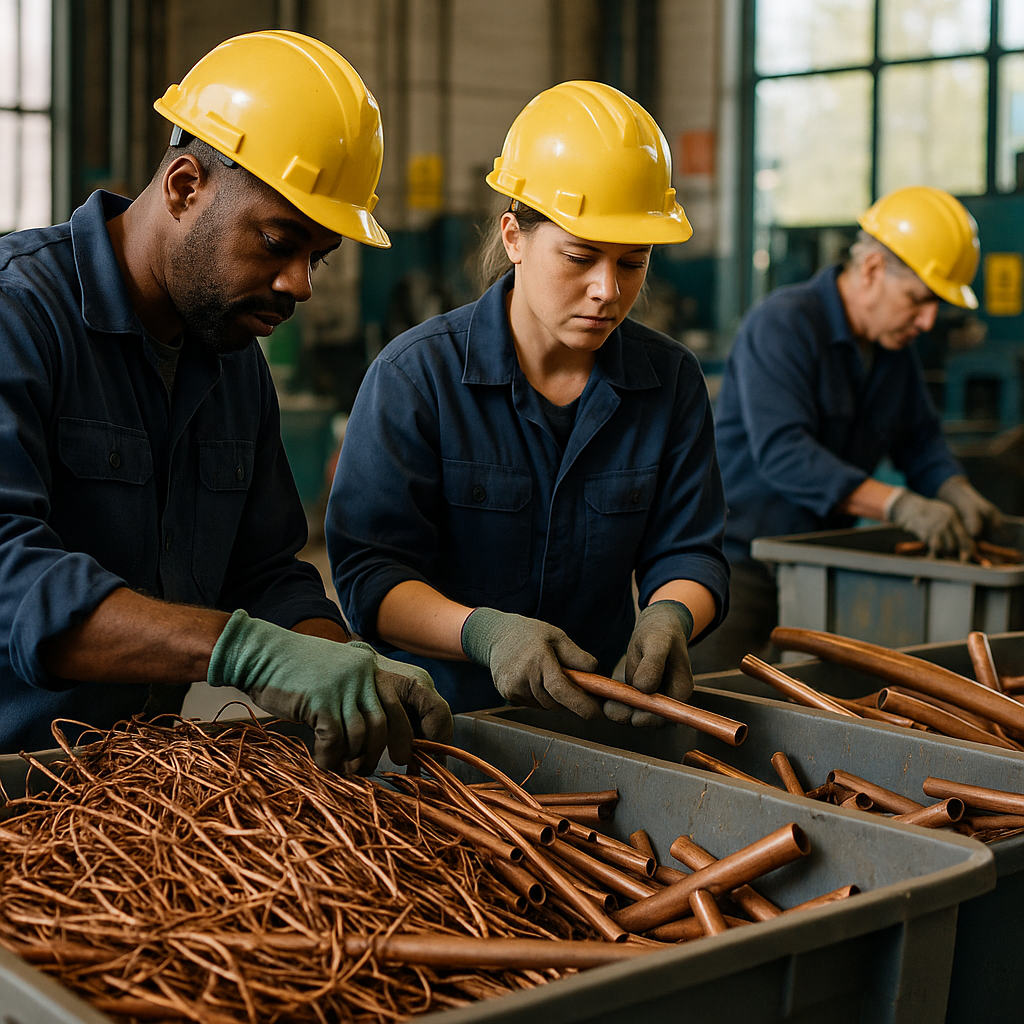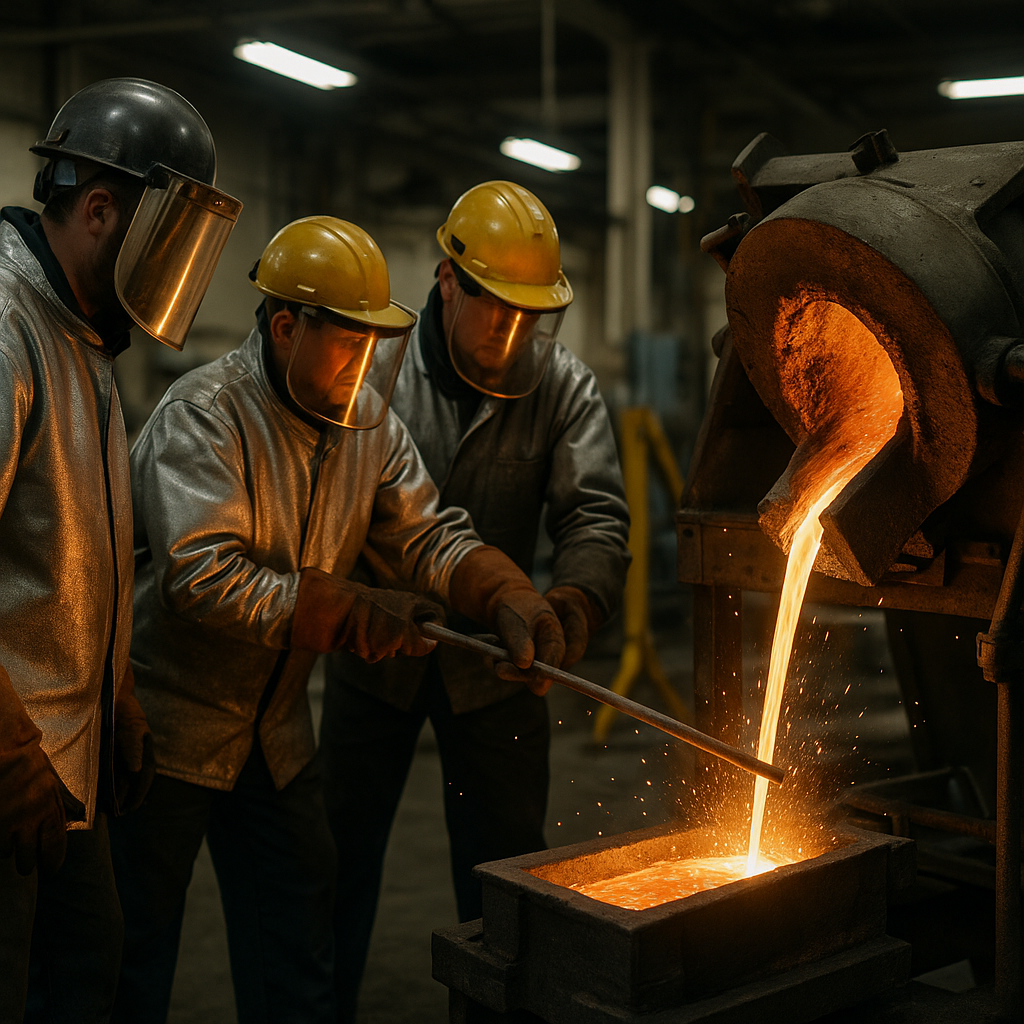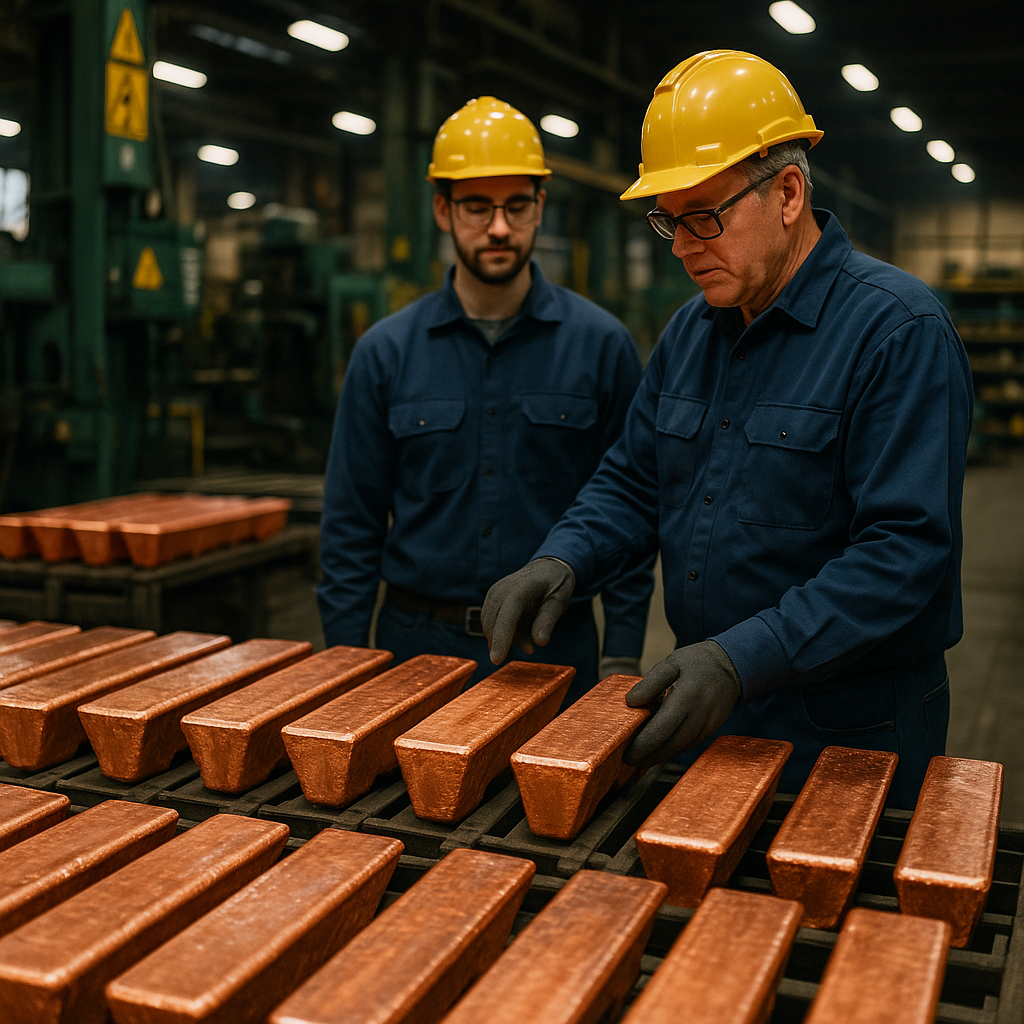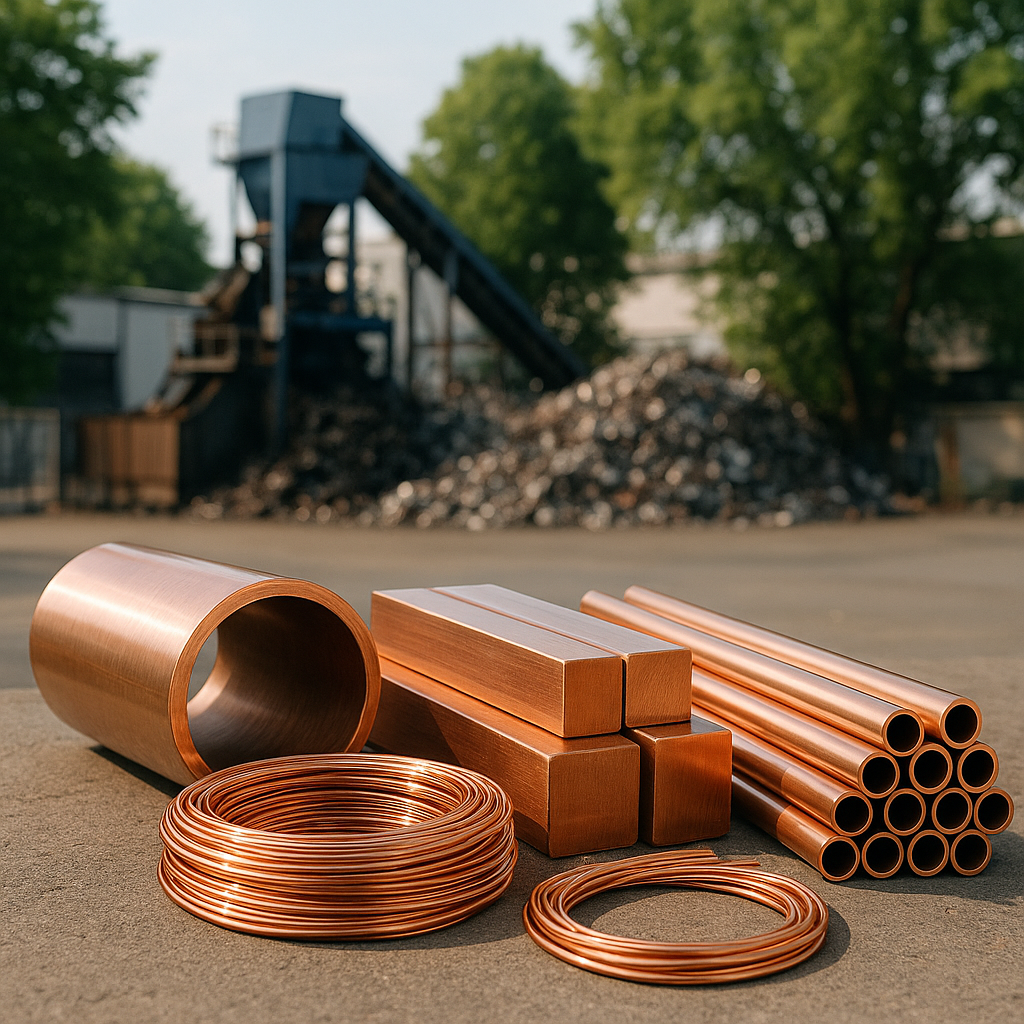5901 Botham Jean Blvd, Dallas, TX 75215
Copper Recycling Process: Collection, Melting, Purification, and Industrial Applications
October 2, 2025Did you know that approximately half of Europe’s copper demand is met by recycled sources? Copper recycling is among the most efficient resource recovery systems globally. This sustainable process transforms discarded copper scrap into fully reusable material without any loss in quality or performance.
Copper recycling follows a straightforward yet sophisticated pathway. It begins with the collection of scrap copper from various sources, including old electrical wiring, plumbing pipes, and discarded electronics. This recovered material is then sorted based on grade and purity before moving to specialized processing facilities.
Once sorted, copper scrap enters the transformation phase: it is shredded into smaller pieces, melted at high temperatures, purified to remove impurities, solidified into ingots, and finally fabricated into new products. This complete cycle uses only 15% of the energy required for mining and processing new copper ore, producing the same quality material.
How is Copper Scrap Prepared for Melting?

Proper preparation of copper scrap is a crucial phase in the recycling process. This multi-stage procedure transforms raw scrap into material ready for efficient melting. Each step is designed to improve purity and optimize the melting process.
Sorting and Classification
The preparation process starts with careful sorting to categorize copper scrap based on purity and composition. Recyclers use various techniques to separate copper into distinct grades, from high-purity bare bright copper to lower-grade materials with contaminants.
A simple magnet test helps separate non-magnetic copper from ferrous metals. Materials are then further classified by visual inspection and sometimes chemical analysis to determine exact copper content. This careful categorization ensures similar materials are processed together, resulting in more predictable melting behavior.
Different copper grades have varying market values, with clean copper fetching higher prices compared to contaminated varieties. Proper sorting enhances melting efficiency and maximizes the economic value of recovered materials.
Cleaning and Contaminant Removal
After sorting, copper scrap undergoes cleaning to remove impurities that could compromise quality. Oil, paint, dirt, and other surface contaminants are eliminated using mechanical or chemical methods. This step is crucial as contaminants can affect the quality of melted copper and cause issues during melting.
For copper wire, removing insulation is particularly important. Mechanical wire strippers effectively remove plastic or rubber coatings without damaging the underlying metal. This boosts the wire’s value by up to 50% while preventing harmful gases during melting.
Size Reduction Through Shredding
Large pieces of copper scrap are then shredded into smaller, uniform sizes. Industrial shredders use powerful cutting blades to process various types and thicknesses of copper scrap simultaneously. This step creates pieces with consistent dimensions, typically ranging from 1 to 3 inches depending on facility requirements.
Size reduction serves several essential functions in the preparation process:
- Increases surface area exposure, allowing for more efficient and even heating
- Improves material density and packing efficiency in melting crucibles
- Creates uniform pieces that melt at more predictable rates
- Facilitates easier handling and transport throughout the facility
- Enables more accurate sorting by revealing internal materials in complex scrap
Modern recycling operations often use specialized shredders calibrated for optimal size reduction without excessive energy consumption. These machines can process several tons per hour while maintaining precise cutting control.
Final Preparation and Inspection
Before entering the furnace, the prepared copper undergoes a final inspection to ensure quality standards are met. This may include sampling for compositional analysis or visual checks for remaining contaminants. Some facilities bundle similar materials using wire or straps for easier handling and accurate weighing.
The carefully prepared copper is then transferred to appropriate containers or directly to melting furnaces. This methodical preparation significantly enhances the melting process’s efficiency, reducing energy consumption and improving the quality of the recovered metal.
Proper preparation ultimately exposes more surface area to heat, removes potential contaminants, and creates uniformity that streamlines the entire melting operation. These practices not only increase operational efficiency but also reduce environmental impact by minimizing energy requirements during the energy-intensive melting stage.
| Method | Feedstock | Production Output | Products | Applications | Notable Benefits |
| Upward Casting Method | High-purity copper scrap | Lower quantities due to batch process | Oxygen-free copper rods, wires | Electronics, high-tech industries | Excellent electrical conductivity and high ductility |
| Continuous Casting and Rolling (CCR) Method | Broad range of copper scrap, including lower-grade material | High production rates due to continuous process | Copper rods, wires, strips | Construction, automotive, general manufacturing | Handles large quantities efficiently |
What Happens During the Copper Melting Process?

Copper melting transforms solid scrap into a molten state inside specialized furnaces at temperatures exceeding 1,000 degrees Celsius. Most industrial operations require about 1,083°C (1,981°F) to liquefy copper fully. At this temperature, copper transforms into a radiant, orange-gold liquid, flowing with remarkable fluidity.
The type of furnace used significantly impacts the melting process. Induction furnaces are the industry standard for copper recycling due to their efficiency and temperature control. These furnaces use electromagnetic currents to heat the copper directly, minimizing energy waste and maintaining consistent temperatures.
As copper heats, it undergoes a complete state change. The molecular bonds loosen, allowing the rigid metal to transform into a vibrant liquid resembling liquid gold. This molten state enables the separation of copper from contaminants through various purification methods.
Purification is critical to producing high-quality recycled copper. During melting, impurities like oxides rise to the surface, creating a layer of dross that can be skimmed off. Other contaminants, such as arsenic, mercury, and sulfur compounds, volatilize at high temperatures and are removed as gases through the furnace’s ventilation system.
Bath agitation plays an important role in impurity removal. Strong agitation within the furnace promotes separation of impurities by bringing them to the surface or volatilizing them. Some advanced melting systems use specific lance technologies to inject air or oxygen-enriched air, creating turbulence that enhances this purification process.
The moisture content in the copper scrap aids in the purification process. As water converts to steam, it helps carry away certain volatile impurities. This is why some smelting operations don’t completely dry their copper inputs before processing.
For highly contaminated copper sources, fluxes may be added to the melt. These compounds chemically bind with specific impurities, making them easier to separate from the copper. Silicon dioxide (silica) is commonly used as a flux to remove iron impurities, forming a slag layer that can be separated from the purified copper.
Once purified, molten copper can be cast into various forms depending on its intended application. For recycling operations, it is typically formed into anodes for further electrolytic refining or cast directly into ingots, rods, or other shapes for manufacturing use.
This careful melting and purification process ensures that recycled copper maintains the high conductivity and performance characteristics required for electrical applications, plumbing, and other demanding uses where material purity directly impacts functionality.
| Furnace Type | Recommended Use | Advantages | Disadvantages |
|---|---|---|---|
| Induction Furnace | High productivity, continuous production | Efficient heating, precise temperature control | Not practical for large-scale copper melting due to high resistivity |
| Resistance Furnace | Applications needing slower heating rates | Simpler, less expensive | Less efficient for high volume production |
| Direct-Arc Furnace | Tonnage melting of copper | Efficient for metallurgy operations | Possible copper loss due to volatilization |
| Tilting Furnace | Larger scale, continuous manufacturing | Large capacity, flexibility in charge material | Higher setup cost |
What Are the Final Steps in Copper Scrap Recycling?

After copper scrap undergoes melting and purification, the recycling process enters its final crucial stages, transforming the purified molten copper into market-ready materials for various industries.
Solidification: From Liquid to Solid Form
Once purified, the molten copper is solidified into standardized forms to facilitate transportation and manufacturing. Recycling facilities cool the molten copper in controlled environments to create shapes based on industry requirements.
Common solidification forms include ingots, rectangular blocks of copper, and billets—longer cylindrical forms. These shapes enhance storage and handling efficiency, preparing the copper for its next life cycle.
The solidification process must be carefully controlled for consistent quality. Rapid cooling techniques expedite this phase without compromising copper’s integrity, resulting in 99.9% pure copper that retains the conductivity and malleability of newly mined copper.
Extrusion: Shaping for Specific Applications
Many recycled copper products undergo extrusion, where solidified copper is forced through specially designed dies to create shapes like tubes, wires, and profiles. This technique allows manufacturers to produce complex cross-sections that other methods cannot easily achieve.
Extrusion begins by heating copper until malleable but not fully molten. Powerful hydraulic presses force the copper through precision-engineered dies, creating products such as tubing for plumbing systems, electrical wiring, and industrial components.
Extrusion enhances copper’s usability by creating forms that meet exact specifications for various applications, from household wiring to specialized industrial equipment.
Fabrication: The Final Transformation
For more complex applications, recycled copper undergoes fabrication processes, including bending, cutting, and welding, to refine the copper into sheet metal, complex parts, and customized components.
Sheet copper, used in roofing, decorative elements, and electronics, results from rolling processes that flatten copper into thin layers. Other methods create components for electrical systems, transportation infrastructure, and renewable energy technologies.
Advanced fabrication techniques allow manufacturers to meet precise specifications while maintaining copper’s excellent thermal and electrical conductivity.
Industry Applications for Recycled Copper
The versatility of recycled copper is evident in its applications across industries. The construction sector uses copper in plumbing systems, roofing, and HVAC equipment. The electrical industry relies on copper’s superior conductivity for wiring, motors, and transformers.
Recycled copper plays a vital role in renewable energy systems. Solar panels and wind turbines use copper components for energy generation and transmission. Transportation equipment incorporates copper in electrical systems and electronic controls.
The electronics industry depends on copper’s conductivity for circuit boards and semiconductor applications. Additionally, medical equipment manufacturers utilize copper for its antimicrobial properties in healthcare settings.
Quality Control in Final Processing
Throughout these final steps, quality control is paramount. Recycling facilities conduct rigorous tests to verify that the processed copper meets industry standards for purity and performance, including electrical conductivity tests, chemical composition analysis, and physical property verification.
Modern recycling operations use advanced technologies like spectrometry and X-ray fluorescence to ensure recycled copper matches the quality of virgin materials. This commitment to quality assurance ensures manufacturers can confidently use recycled copper in even the most demanding applications.
The thoroughness of these final processing steps guarantees that recycled copper enters the manufacturing stream with properties virtually identical to newly mined copper but with a significantly reduced environmental impact.
Conclusion: The Impact of Melting Copper Scrap

Melting copper scrap is a crucial step in the recycling process that offers substantial environmental benefits. It requires up to 85% less energy compared to extracting and processing virgin copper ore, significantly reducing greenhouse gas emissions and the carbon footprint. This energy efficiency results in significant climate advantages and helps conserve finite copper reserves for future use.
Additionally, copper recycling through melting prevents valuable materials from ending up in landfills, reduces habitat destruction due to mining, and decreases the extraction of increasingly lower-grade copper ores. The ability to recycle copper indefinitely without quality loss highlights its importance in supporting circular economy principles, where materials continue to serve productive purposes instead of becoming waste.
For your copper recycling needs, contact Okon Recycling at 214-717-4083.
